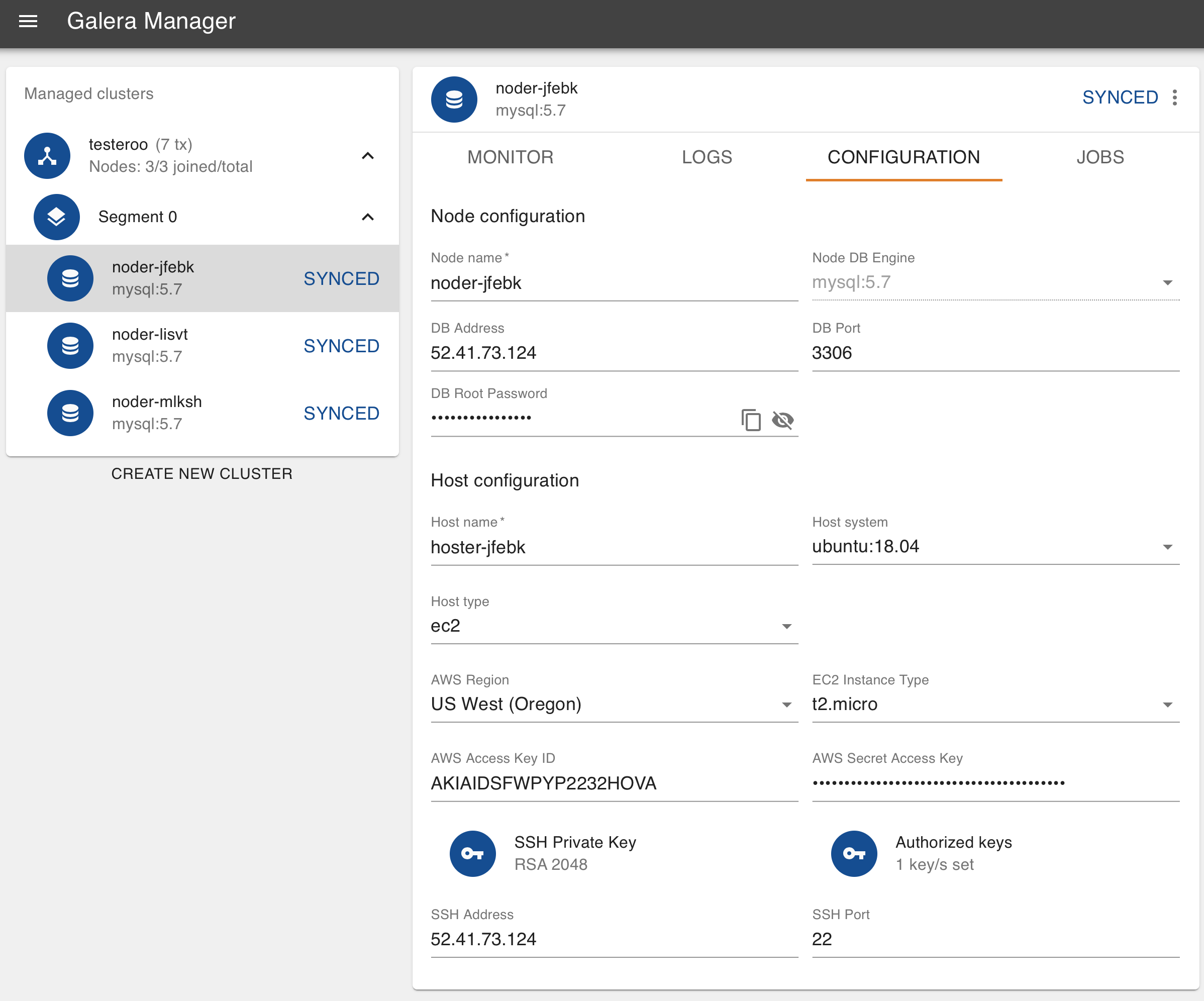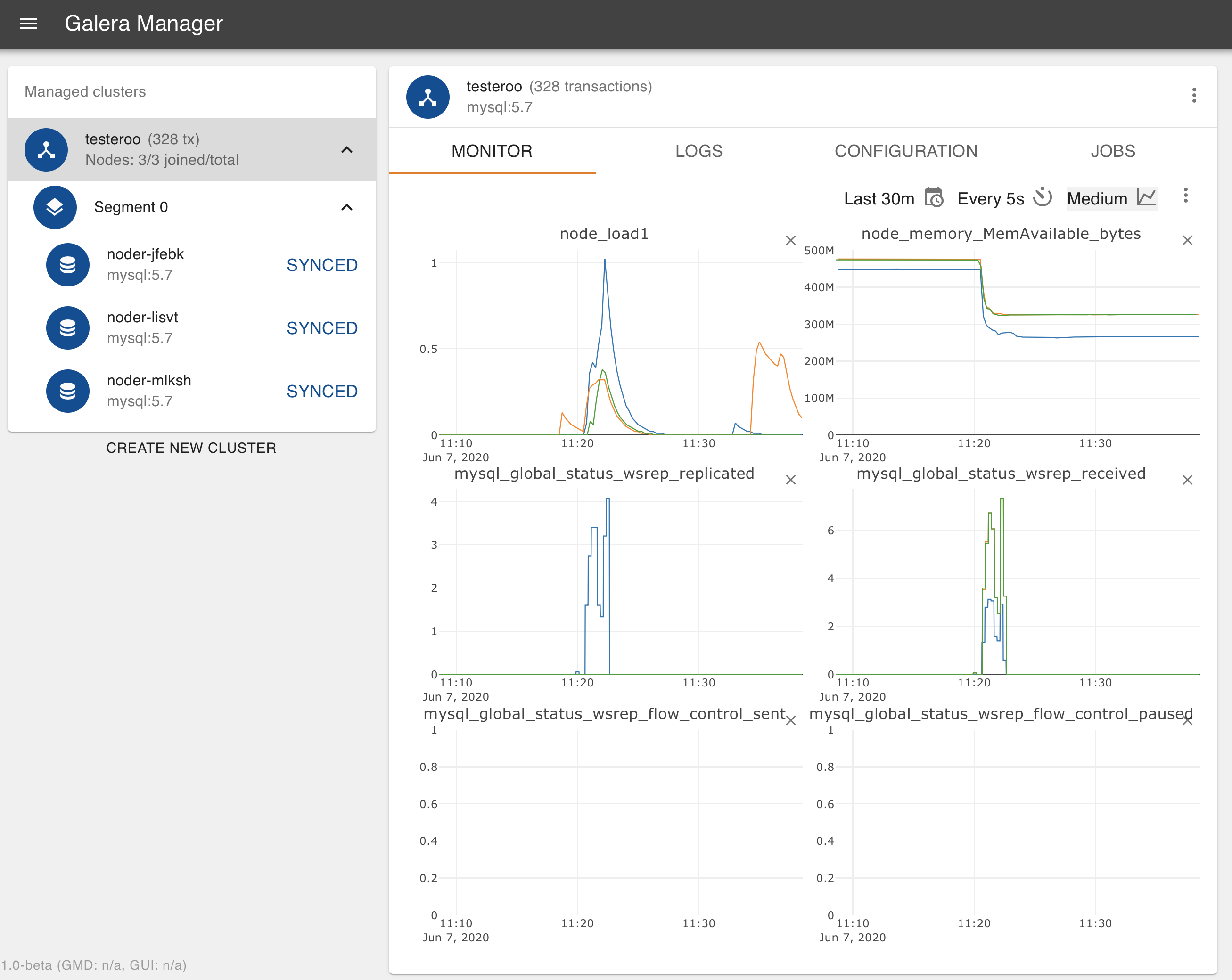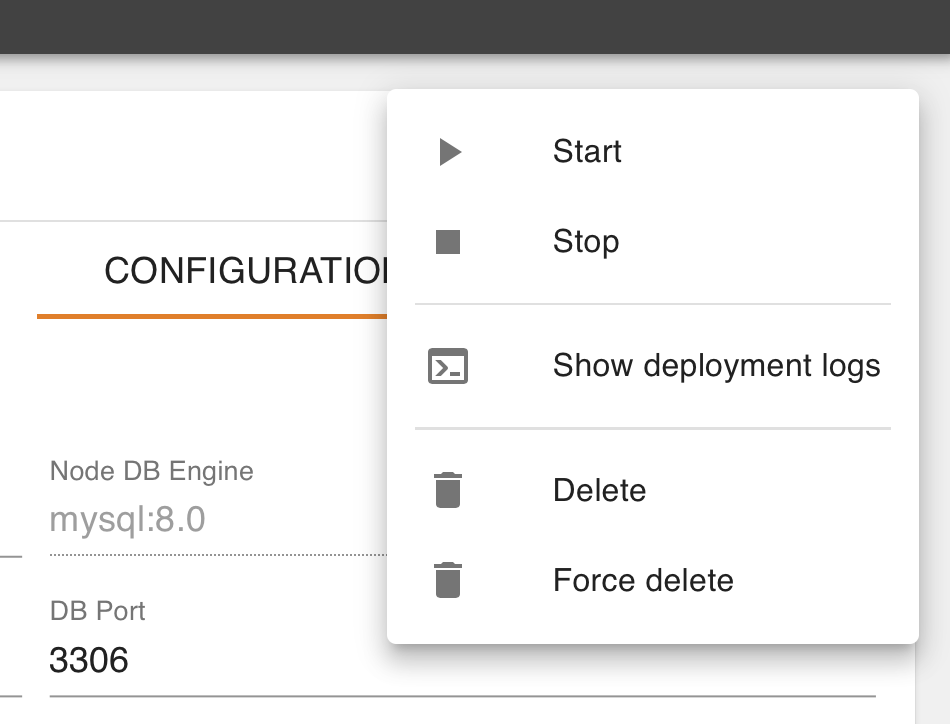Galera Manager Documents
Related Articles
Loading Initial Data¶
After you create a Galera Cluster and add nodes with Galera Manager, you’ll probably want to load data from a previous database, to migrate data from another server or cluster. This is not a feature of Galera Manager since its main focus is the logistics and monitoring of clusters and nodes, not the data contained in the databases.
To load the initial data in a new Galera Cluster created within Galera Manager, you’ll have to use standard methods, of which there are a few. This page of the Codership documentation explains how to log into one of the hosts, and how to use common, basic methods to load data into a node.
If you’re unfamiliar with how to make a back-up on an existing Galera Cluster, you could read the Backup Cluster Data documentation page first. There are also links in the margin to tutorials on making back-ups and loading back-ups to a node of a new cluster—regardless of whether Galera Manager was used to create the cluster.
Node Credentials
After you first create a new cluster using Galera Manager, and have added a few nodes, you will need to log into one of the nodes to load the initial data. This will require you to get the IP address and password for one of the nodes. Just select a node in Galera Manager and then click on the Configuration tab for the node. You can see an example of this in the screenshot in Figure 1 below:
If you will be restoring data by way of a MySQL client (e.g., using mysql to restore a dump file), you’ll need the node’s IP address. In the main panel shown here, near the top left of the Configuration tab, is the external IP address of the node. It’s contained in the DB Address field: it’s 52.41.73.124 in this example. You’ll also need the MySQL or MariaDB root password. Incidentally, since it’s a new installation of MySQL or MariaDB, there’s only the root user. To get the DB Root Password—as it’s labeled here—click on the icon of an eye to reveal it, or click the icon of two sheets of paper to copy the password to your clipboard.
If you prefer using rsync, or similar utilities for making physical back-ups, will need the SSH Address, which is at this point the same as the DB Address, as well as the private encryption key associated with the public encryption key you gave when creating the nodes. If you didn’t provide one, you cannot add one to any existing nodes. However, you can add new node and give it a public key for which you have the private key. Then you can load the initial data to that node and delete the node after the other nodes have synchronized with it.
Methods to Load Initial Data
With the correct IP address and either the database password or the private encryption key, you’re ready to load the initial data to one of the nodes. There are two common methods of loading data into MySQL or MariaDB: restoring from a logical or a physical back-up.
Loading Logically
Logical back-ups are generated with a utility like mysqldump and produce text files (i.e., dump files) containing SQL statements which may be used to rebuild databases. See the tutorial, Galera Cluster Backups for more details on how to use mysqldump to make a back-up.
With the node’s IP address and the password for root in the database, you can use a MySQL client to load data from a dump file. The example below shows how to restore a dump file made with mysqldump:
mysqldump File (Example 1)¶mysql -p -u root -h 52.41.73.124 < company-20200607.sql
This line above would be executed on another server where the dump file (i.e., company-20200607.sql) is located. The host address here is for the node into which it will be loading the data. When it asks for the password, you would give it the one you copied from the node in Galera Manager.
The dump file contains SQL statements that will execute CREATE DATABASE and CREATE TABLE statements, as well as plenty of INSERT statements to recreate the databases, tables, and rows of data on the new node—in the new Galera Cluster. It will run for quite a while, but when it’s finished, you might execute an SQL statement like the following from the command-line:
mysql -p -u root -h 52.41.73.124 -e "SHOW TABLES FROM company"
+----------------------+
| Tables_in_company |
+----------------------+
| clients |
| clients_addresses |
| clients_email |
| clients_telephones |
| employees |
| employees_email |
| employees_salaries |
| employees_telephones |
| org_departments |
| org_divisions |
| org_offices |
| org_warehouses |
| ref_job_titles |
| ref_name_titles |
| ref_states |
+----------------------+
The results table in Example 2 here shows that the company database was created and so were the tables for it. You could check further by executing some SELECT statements to ensure the data was inserted.
You might also go back to Galera Manager to see how the activity looks for your nodes. Below is a screenshot of Galera Manager that was taken shortly after loading the dump file above:
Notice the first chart at the top left for the cluster has no activity and then there’s a spike of activity. There are three line graphs showing spikes because there are three nodes: one is the data being loaded from the mysql client and the other two nodes are replicating data that the first node is receiving.
Loading Physcially
The other common method of making back-ups is to use physical back-ups. This is fairly simple: it’s mostly just a copy of MySQL’s data directory. Typically, administrators use rsynch to make a back-up copy of the data directory and othere relavent files. Then they use tar and gzip to make a compressed archive file. See the tutorial, Galera Cluster Backups for more details on this process.
To restore a physical back-up, you’ll need to copy the back-up file to one of the nodes in the new cluster you created with Galera Manager. This is where you’ll need the node’s IP address and private encryption key mentioned the Node Credentials section of this documentation page.
To copy the back-up file to the node, you can use an FTP program. You might also use scp to make a secure copy from the old server where the back-up is located, to the new node. First, you may want to log into the host for the new node. You could do that by entering something like the following from the command-line of a local computer:
ssh -i ~/.ssh/galera-manager root@52.41.73.124
The name of your private key and your node’s IP address will be different. Notice it requires you use the user name, root. That’s the only user since this is a new node.
If your old server requires a encryption key, you’ll have to copy it to the node—be sure to delete the key when you’re finished. If your old server requires only a user name and password, you might scp like so:
scp -p admin@35.161.145.71:/backups/galera-rsync-backup-20200607.tgz .
This line uses scp to copy the back-up file from another Ubuntu server to the new node, to the current directory.
After the back-up file has been copied, you’ll need to stop mysqld on the node before you can overwrite the databases’s data directory. Although you can do this from the command-line, you should stop the node from Galera Manager: click on the node and then the vertical ellipsis at the top right. This will open a dialog box like the one below:
When you click on Stop, only mysqld will be stopped. You would extract the back-up file’s contents and copy the files to the MySQL data directory:
tar -xvzf galera-rsync-backup-20200607.tgz
When you’re finished, go back to Galera Manager and start the node. As soon as mysqld starts, the other nodes should synchronize the data you’ve restored. You could execute a few SQL statements on one of the other nodes to see if they have the data, as shown in Example 2.
Galera Manager Documents
- Getting Started
- Installing
- AWS Ports
- gmd Daemon
- Deploying Clusters
- Adding Nodes
- Adding Users
- Loading Data
- Monitoring a Cluster
- Upgrading
Related Articles



